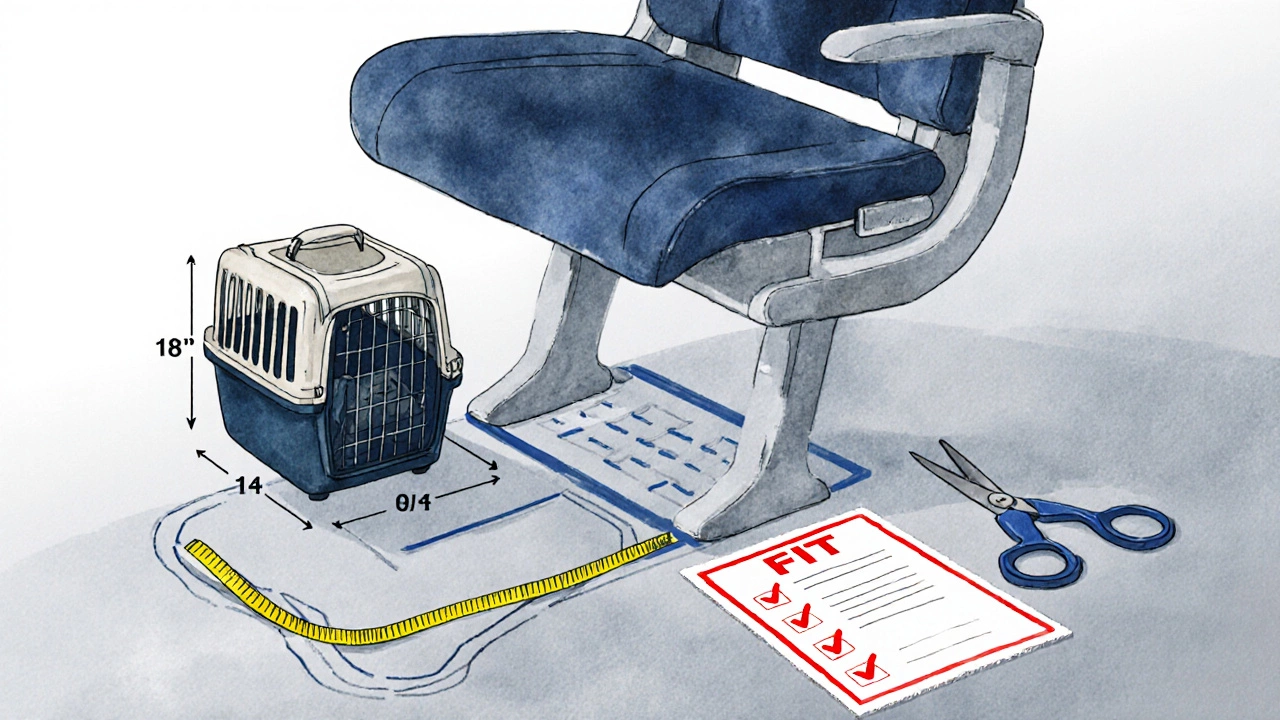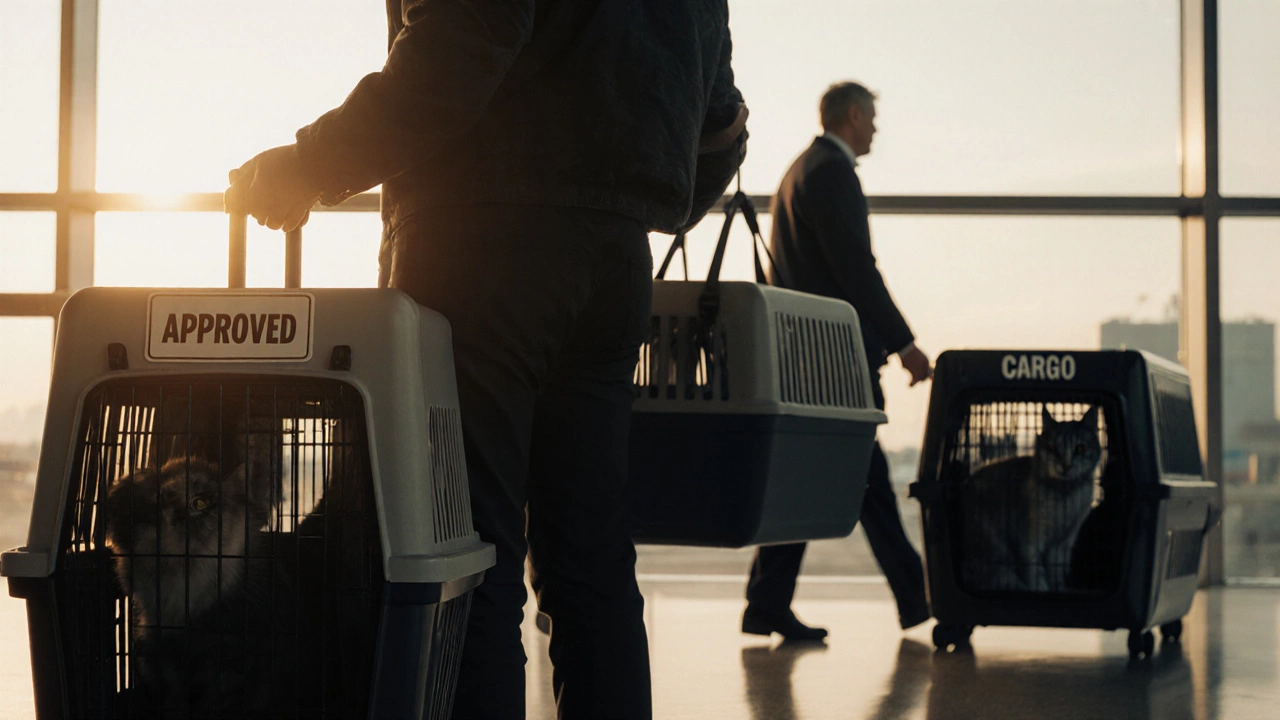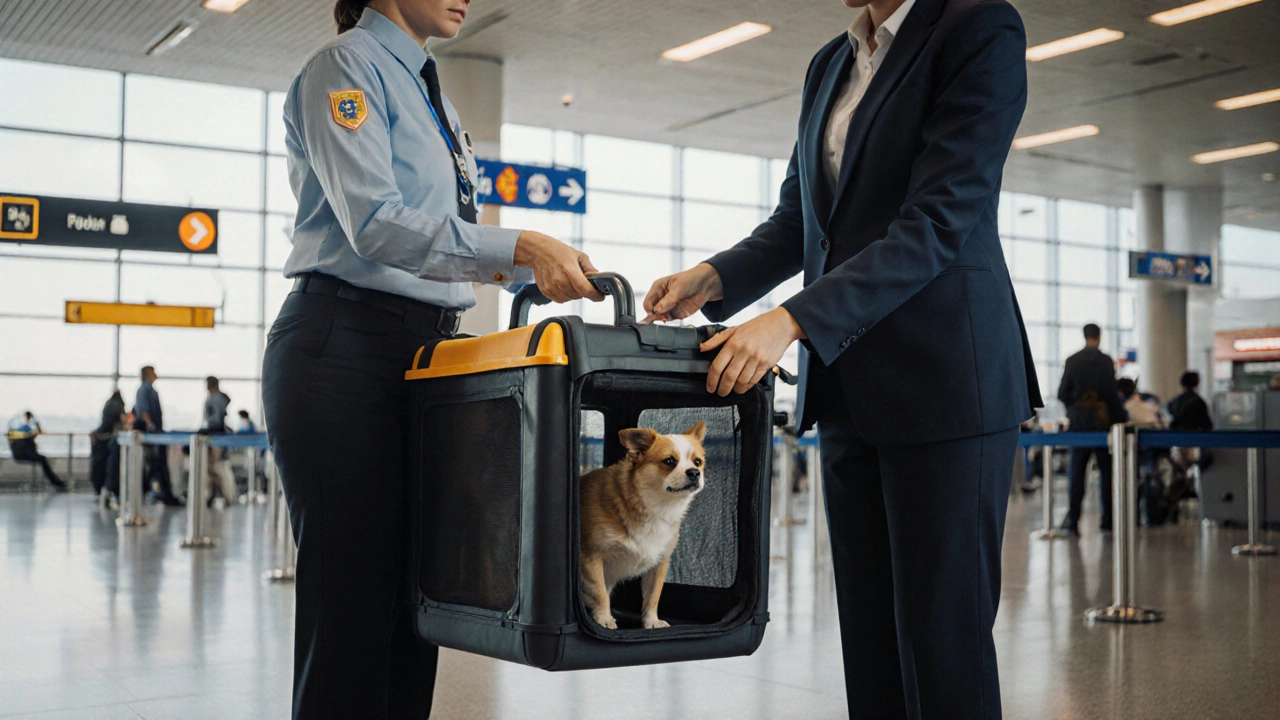Pet Carrier Size Checker
Check Your Pet Carrier Size
Enter your pet carrier's dimensions and select your airline to see if it fits under the seat.
Every year, over 1 million pets fly in the cargo hold or cabin of commercial airplanes. But if you’ve ever packed a pet carrier and wondered, Do airlines check pet carrier size? - you’re not alone. The answer isn’t simple. Some airlines measure carriers at the gate. Others don’t. Some let you get away with a slightly oversized bag. Others turn you away with no warning. And if you’re flying with a cat or small dog, getting this wrong could mean missing your flight - or worse, your pet being sent to a holding facility.
Why Carrier Size Matters More Than You Think
Airlines don’t just care about size because they’re being picky. Pet carriers have to fit under the seat in front of you. That’s not a suggestion - it’s a safety rule. If the carrier sticks out into the aisle, it becomes a tripping hazard. In turbulence, an oversized carrier can slide, hit another passenger, or block emergency exits. That’s why every major U.S. airline has a strict size limit.The most common maximum size for in-cabin pet carriers is 18 x 11 x 11 inches. That’s about the size of a standard carry-on suitcase. But here’s the catch: airlines measure the carrier’s external dimensions, not the internal space. So if your carrier has thick padding, bulging seams, or a rigid frame, it might look fine inside - but the outside could be too big.
One traveler in Chicago brought a carrier labeled ‘airline approved’ by the manufacturer. At the gate, the agent used a rigid sizer box. The carrier’s handle stuck out by half an inch. The dog had to be checked as cargo - a $200 fee, a 3-hour delay, and a stressed-out pup. That could’ve been avoided.
How Airlines Actually Check Carrier Size
Most airlines don’t measure carriers at check-in. They wait until boarding. That’s when the gate agent pulls out a plastic or metal sizer box - usually labeled with the airline’s logo and the max dimensions. The carrier must slide in easily, with no part sticking out. No forcing. No wiggling. If it doesn’t fit, it doesn’t fly in the cabin.Some airlines, like Southwest and Alaska, are stricter. They use the same box for every passenger. Others, like Delta and American, might be more lenient - but only if the carrier is soft-sided and the flight isn’t full. On a packed flight? Even a carrier that fits 99% of the time might get flagged.
There’s no universal standard. United’s limit is 18 x 11 x 11 inches. JetBlue allows 17 x 12 x 10 inches. Hawaiian Airlines says 16 x 14 x 9 inches. That’s why you can’t just buy a carrier labeled ‘airline approved’ and assume it works everywhere. You have to check the airline’s website - and measure it yourself.
What Happens If Your Carrier Is Too Big?
If your carrier doesn’t fit the sizer box, you have three choices:- Check the pet as cargo - this costs $150-$300, depending on the airline and route.
- Reschedule your flight - you might get a free change if you’re early enough, but not always.
- Leave the pet behind - yes, this happens. Airlines aren’t required to let you board if your pet doesn’t meet requirements.
Most people don’t realize that checking a pet as cargo is a whole different process. Your pet won’t be with you. They’ll be loaded into a pressurized, temperature-controlled hold - but it’s still stressful for them. And if your flight is delayed or canceled, your pet could sit on the tarmac for hours.
One owner in Atlanta tried to fly with her 12-pound cat in a carrier that was 19 inches long. The agent offered to check it for $225. She canceled the flight, drove 8 hours instead, and saved $200 - plus avoided the trauma for her cat. Sometimes, the cheapest option isn’t the ticket - it’s the detour.
Soft vs. Hard Carriers: What Works Best
Soft-sided carriers are the most popular - and for good reason. They’re flexible, lightweight, and often easier to squeeze into tight spaces. But they’re also easier to misjudge. A soft carrier might look small when empty, but once your pet steps inside, the sides bulge out. That’s why many airlines require the carrier to be rigid enough to hold its shape - even when your pet moves around.Hard-shell carriers are more reliable. They don’t change shape. They’re easier to measure. But they’re heavier, harder to store, and sometimes too bulky for the sizer box. The best compromise? A soft carrier with a rigid frame and no protruding handles or zippers. Look for models with a flat top and no wheels or external pockets.
Brands like Sherpa, Petmate, and SturdiBag are commonly used because they’re designed to fit airline sizer boxes. But even those can vary by model. Always check the exact dimensions on the manufacturer’s site - not just the product title.

How to Measure Your Carrier the Right Way
Here’s how to avoid last-minute surprises:- Measure the carrier’s outer dimensions: length, width, and height - including handles, wheels, and buckles.
- Use a ruler or tape measure - don’t guess.
- Compare your measurements to the airline’s published limit. Don’t trust ‘airline approved’ labels.
- Print out the airline’s pet policy and bring it with you.
- Test the carrier in a sizer box if you can. Some pet stores have them.
Pro tip: Measure your carrier before you pack. Don’t wait until the airport. If it’s close to the limit, buy a smaller one. A $40 carrier is cheaper than a $250 last-minute cargo fee.
What Airlines Actually Say
Here’s a quick breakdown of the top U.S. airlines’ in-cabin pet carrier limits as of 2025:| Airline | Max Dimensions (inches) | Weight Limit | Notes |
|---|---|---|---|
| Delta Air Lines | 18 x 11 x 11 | 20 lbs (pet + carrier) | Soft-sided only. No wheels or handles sticking out. |
| American Airlines | 18 x 11 x 11 | 20 lbs | Only one pet per passenger. Carrier must fit under seat. |
| United Airlines | 18 x 11 x 11 | 20 lbs | Reservations required. No snub-nosed breeds in cargo. |
| Southwest Airlines | 18.5 x 13.5 x 8.5 | 20 lbs | Strictest sizer box. No exceptions. |
| JetBlue | 17 x 12 x 10 | 20 lbs | Only one pet per customer. No oversized carriers. |
| Hawaiian Airlines | 16 x 14 x 9 | 25 lbs | Only for inter-island flights. No mainland U.S. pet travel. |
| Alaska Airlines | 18 x 11 x 11 | 20 lbs | Allow two pets per passenger on some routes. |
Notice how Southwest’s height limit is just 8.5 inches? That’s because their seats have less under-seat clearance. A carrier that fits on Delta might not fit on Southwest. Always double-check the airline, not just the country.
What About International Flights?
International rules are even stricter. The EU requires carriers to be IATA-compliant and have ventilation on all four sides. Canada requires a health certificate issued within 10 days of travel. Japan bans all soft-sided carriers. And some airlines, like Emirates and Lufthansa, require you to book pet travel months in advance - even for cabin pets.If you’re flying outside the U.S., go to the airline’s website and search for ‘pet travel policy’. Don’t rely on third-party sites. Regulations change often, and outdated info can cost you your trip.

Final Checklist Before You Fly
Use this before you leave for the airport:- Confirm your pet’s carrier fits the airline’s exact size limit - measure it yourself.
- Remove all wheels, handles, or external pockets that could add bulk.
- Make sure your pet is calm and used to the carrier - test it at home for a few days.
- Bring a copy of the airline’s pet policy printed out or saved on your phone.
- Arrive at the airport 2 hours early - gate agents need time to check carriers.
- Keep your pet’s health certificate and vaccination records handy.
There’s no magic trick. The only way to guarantee your pet flies in the cabin is to make sure the carrier fits - not almost fits, not ‘probably fits’ - fits.
Frequently Asked Questions
Do all airlines check pet carrier size at the gate?
Most major U.S. airlines do. Smaller regional carriers might not, but they’re rare. If you’re flying with Delta, United, Southwest, or Alaska, expect a sizer box at the gate. Don’t assume you’ll get a pass just because you’ve flown before - policies are enforced more strictly now than in past years.
Can I use a backpack-style pet carrier?
Yes - if it meets the size limit and has no rigid frame or protruding parts. Many backpack carriers are too tall or have stiff sides that don’t compress. Test it in the airline’s sizer box before you go. Brands like Petmate Sky Kennel and Sherpa Deluxe have backpack models that work, but not all do.
What if my pet is slightly over the weight limit?
Weight limits include the carrier. If your dog weighs 19 pounds and the carrier is 3 pounds, you’re at 22 - that’s over. Airlines don’t weigh pets on a scale, but if the carrier looks too heavy or your pet is clearly large, they may ask you to check it. Some airlines allow a 1-2 pound buffer, but don’t count on it.
Can I bring two small pets in one carrier?
Only if they’re from the same household and the airline allows it. Most airlines permit two pets in one carrier only if they’re small enough to fit comfortably and weigh under 20 pounds total. Check the airline’s policy - some, like Southwest, allow it. Others, like JetBlue, don’t.
Do emotional support animals still fly in the cabin?
No. As of December 2020, the U.S. Department of Transportation no longer requires airlines to allow emotional support animals in the cabin. Only service animals trained to perform specific tasks are permitted. Some international airlines still allow ESAs, but U.S. carriers do not.
What to Do If You’re Turned Away
If your pet doesn’t make the cut, stay calm. Arguing won’t help. Ask the agent if you can reschedule for free. Some airlines offer one free change if you’re caught at the gate with an oversized carrier. If not, consider driving or using a pet transport service. Many companies specialize in door-to-door pet travel - they handle paperwork, carriers, and even airport drop-offs. It’s pricier than flying, but it’s stress-free for you and your pet.Remember: the goal isn’t to get your pet on the plane - it’s to get them there safely and calmly. A small carrier that fits? That’s the win. Everything else is just noise.
